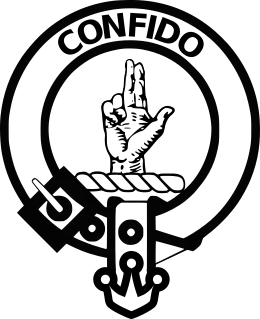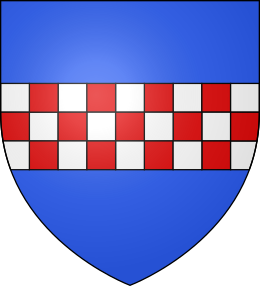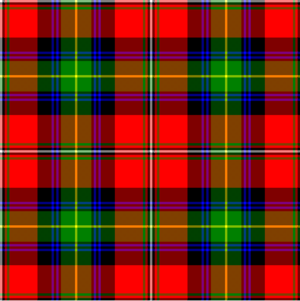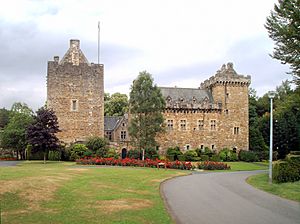Clan Boyd facts for kids
Clan Boyd is a Scottish clan from the Scottish Lowlands. It is officially recognized by the Lord Lyon King of Arms, who is the head of heraldry in Scotland.
Quick facts for kids Boyd |
|||
|---|---|---|---|
| Buidhe | |||

Crest: A dexter hand erect and pale having the outer fingers bowed inwards
|
|||
| Motto | Confido (I trust) | ||
| Profile | |||
| Region | Lowlands | ||
| District | Ayrshire | ||
| Plant badge | Laurel leaves | ||
 |
|||
| Boyd has no chief, and is an armigerous clan | |||
| Seat | Kilmarnock | ||
| Historic seat | Dean Castle, Ayrshire | ||
| Last Chief | Alastair Boyd, 7th Baron Kilmarnock | ||
| Died | 19 March 2009 | ||
|
|||
|
|||
|
|||
|
|||
Contents
History of Clan Boyd
Where the Name Boyd Comes From
The name Boyd is thought to describe someone's looks. It comes from the Scottish Gaelic word buidh, which means fair or yellow. Another idea is that it comes from Bòd, the Gaelic name for the Isle of Bute.
One of the first Boyds mentioned in history was Robert de Boyd. In 1205, he was a witness to an important agreement. Later, in 1296, Robert de Boyte showed his loyalty to King Edward I of England by signing the Ragman Rolls.
Brave Boyds in Early Wars
The Boyds became important in Scottish history during the Battle of Largs in 1263. This was a big fight against Viking invaders. Robert Boyd was given a special job to clear Vikings from a hill. As he left, King Alexander III shouted "Confido!" (meaning "I trust"). This became the clan's motto and symbol. Robert Boyd and his men succeeded, helping the Scots win the battle.
Later, in the 1290s, the Boyds joined William Wallace to fight for Scotland's freedom from England. Duncan Boyd was even executed in 1306 for supporting Scottish Independence.
During the Wars of Scottish Independence, Sir Robert Boyd was a strong supporter of King Robert the Bruce. He was a key leader at the famous Battle of Bannockburn in 1314. For his bravery, he received lands like Kilmarnock and other areas in Ayrshire.
Clan Fights in the 1400s
Clans in Scotland often had feuds, which were long-running conflicts. Sir Thomas Boyd, the 8th chief, was involved in a feud with the Stewarts of Darnley. He was killed in a battle at Craignaucht Hill in 1439 by Alexander Stewart. The Boyds were outnumbered, but they fought bravely. This fight did not end the feud, as more revenge killings happened later.
Boyds and the Royal Family
The chief of Clan Boyd became very important when he was made Lord Boyd of Kilmarnock by King James II of Scotland. When King James II died, Robert Boyd, 1st Lord Boyd became one of the regents, helping to rule Scotland for the young King James III of Scotland. Lord Boyd's younger brother also became the king's military teacher.
Lord Boyd's son, Thomas, married Princess Mary, the king's sister. He was given the title Earl of Arran.
However, the Boyds' success made them powerful enemies. In 1469, Lord Boyd, his son Thomas, and his brother Alexander were called to face charges. Lord Boyd escaped to England. His brother Alexander was executed. Thomas, the Earl of Arran, was abroad on royal business and chose to stay in exile.
Later, James Boyd, 2nd Lord Boyd, the 11th chief, was killed in a feud in 1484. His uncle, Alexander Boyd, 3rd Lord Boyd, became the 12th chief. He was a favorite of King James IV of Scotland.
The 1500s: Back in Royal Favor
The Boyd family regained royal favor when Robert Boyd, 4th Lord Boyd had his family's lands and titles given back to him. This happened during the reign of Mary, Queen of Scots.
Lord Boyd was one of the first to join Queen Mary after she escaped from Lochleven Castle. He fought for her at the Battle of Langside. He also visited her many times when she was held captive in England. He passed away in 1590.
The 1600s: Supporting the King
During the Wars of the Three Kingdoms, Clan Boyd supported the King. After the King was restored to power in 1660, William, Lord Boyd, was given the title Earl of Kilmarnock.
The 1700s: Jacobite Risings
The third Earl of Kilmarnock did not support the Jacobite rising of 1715. He led a group of volunteers for the government. However, his son, the fourth Earl, supported the Jacobite rising of 1745. He fought for Charles Edward Stuart (Bonnie Prince Charlie) at the Battle of Culloden in 1746.
The fourth Earl was captured at Culloden and taken to the Tower of London. He was executed in 1746. All of the Boyd titles were then taken away. However, his oldest son later inherited the title of Earl of Erroll through his mother and changed his last name to Hay.
Modern Clan Boyd
The 22nd Earl of Erroll passed away in 1941. His daughter became the Earl of Erroll and chief of Clan Hay. However, the title of Baron Kilmarnock could only pass to males. So, the 22nd Earl's brother took the name Boyd again and became the Baron of Kilmarnock.
Clan Chief
The chief is the leader of the clan. Alastair Boyd, 7th Baron Kilmarnock, who was the Chief of Clan Boyd, passed away on March 19, 2009. His brother, Dr. Robin Boyd, is next in line for the title of Baron and Chief.
Chiefly Arms and Crest
The chief of Clan Boyd has a special coat of arms. The crest badge used by clan members has the motto CONFIDO, which means "I trust". The crest shows a hand pointing upwards with the outer fingers bent inwards. Clan members wear this badge to show their loyalty to the chief and the clan.
Clan Castles
- Dean Castle, also known as Kilmarnock Castle, was the main home of the Clan Boyd chiefs.
- Portencross Castle was given to the Boyds by Robert the Bruce.
- Bedlay Castle was built by the Boyds in the 1500s. They sold it in 1642.
- Badenheath Castle was owned by Robert Boyd of Badenheath. He supported Queen Mary in 1568. The castle was later torn down in 1953.
- Brodick Castle was held by the Boyds when they were Earls of Arran from 1467 to 1469. It is now open to the public.
- Callendar House was leased by William Boyd, 4th Earl of Kilmarnock in 1715. It is now open to the public.
- Law Castle in Ayrshire was owned by the Clan Boyd for a long time before being sold in 1670.
- Little Cumbrae Castle
- Penkill Castle was held by the Boyds for many years.
- Pitcon Castle near Dalry was owned by the Boyds until the 1770s.
- Trabboch Castle was held by the Boyds in the 1300s. It later passed to other clans.



